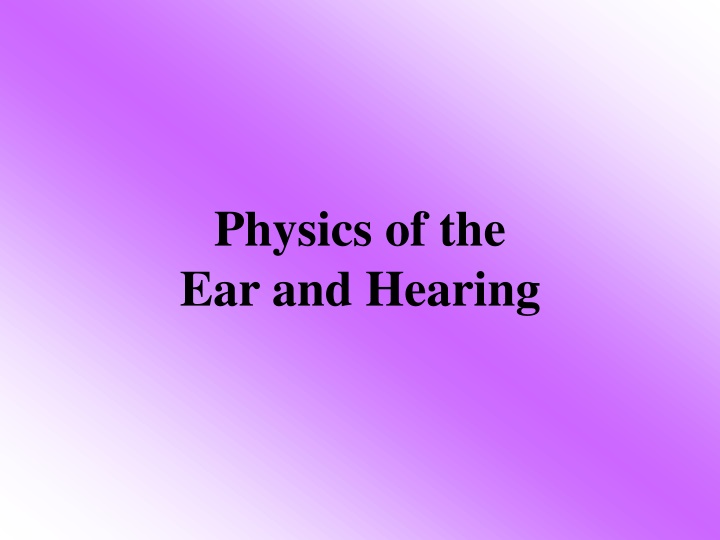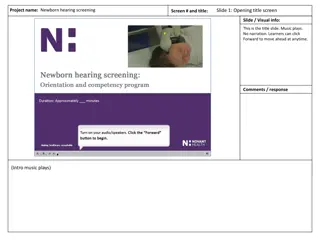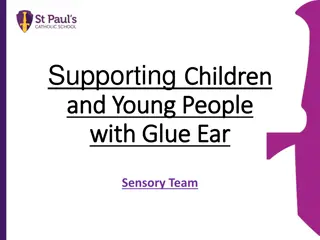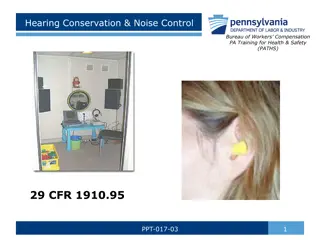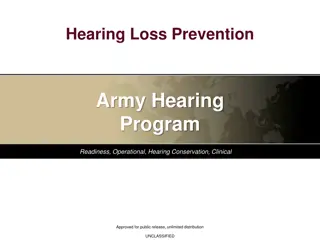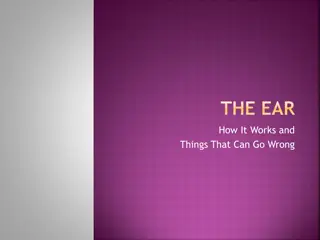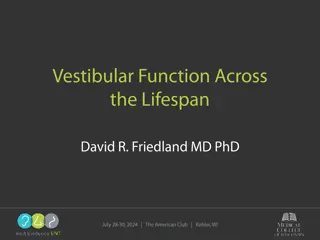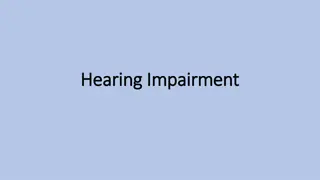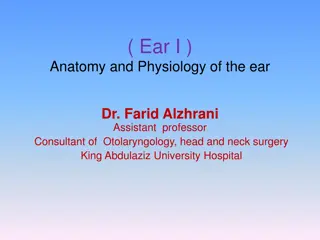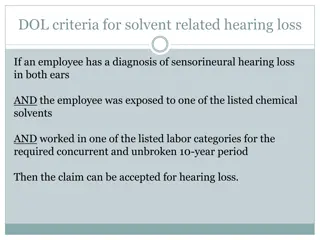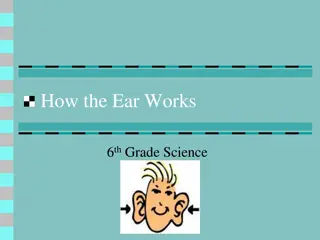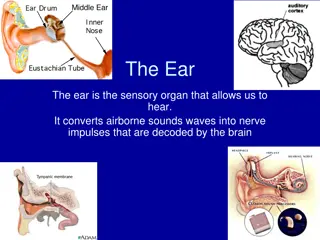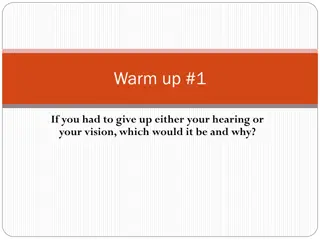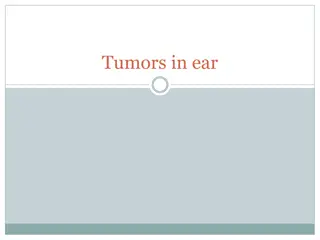Exploring the Physics of Hearing and the Incredible Mechanics of the Ear
Discover the fascinating world of hearing and speech communication, delving into the intricate workings of the human ear. From the importance of speech and hearing for human interaction to the inner mechanisms of the ear's ability to convert sound waves into electrical signals for the brain, this exploration sheds light on the intricacies of our auditory system.
Uploaded on Sep 26, 2024 | 2 Views
Download Presentation

Please find below an Image/Link to download the presentation.
The content on the website is provided AS IS for your information and personal use only. It may not be sold, licensed, or shared on other websites without obtaining consent from the author.If you encounter any issues during the download, it is possible that the publisher has removed the file from their server.
You are allowed to download the files provided on this website for personal or commercial use, subject to the condition that they are used lawfully. All files are the property of their respective owners.
The content on the website is provided AS IS for your information and personal use only. It may not be sold, licensed, or shared on other websites without obtaining consent from the author.
E N D
Presentation Transcript
Physics of the Ear and Hearing
Speech and hearing are the most important means by which we communicate with our fellow man. Through hearing we receive speech sounds from others and also listen to ourselves! In some ways it is more of a handicap to be born "stone deaf'' than to be born blind. Any child who cannot hear the sounds from his own vocal cords cannot learn to talk without special training. In earlier times a child deaf from birth was also mute, or dumb, and since so much of our learning takes place through hearing, he often was not educated. While deaf people can now be taught to speak, their voices usually sound abnormal since they have no easy way to compare them to the voice sounds produced by other people.
If a sound is loud enough, it can be "heard" by a deaf person through the sense of touch; for example, he may feel vibrations of the exposed hairs on his body and thus "hear" the loud sound through the nerve sensors at the roots of the hairs. The sense of hearing is in some ways more remarkable than the sense of vision. We can hear a range of sound intensities of over a million million (1012), or 100 times greater than the range of light intensities the eye can handle. The ear can hear frequencies that vary by a factor of 1000, while the frequencies of light that the eye can detect vary by only a factor of 2.
The sense of hearing involves: - 1. The mechanical system that stimulates the hair cells in the cochlea. 2. The sensors that produce the action potentials in the auditory nerves. 3. The auditory cortex, the part of the brain that decodes and interprets the signals from the auditory nerves. Deafness or hearing loss results if any of these parts malfunctions. The ear is a cleverly designed converter of very weak mechanical waves in air into electrical pulses in the auditory nerve.
The ear is usually thought of as divided into three areas: - The outer ear consists of the ear canal, which terminates at the eardrum (tympanic membrane). The middle ear includes the three small bones (ossicles) and an opening to the mouth (Eustachian tube). The inner ear consists of the fluid-filled, spiral-shaped cochlea containing the organ of Corti. Hair cells in the organ of Corti convert vibrations of sound waves hitting the eardrum into coded nerve pulses that inform the brain of these sound waves.
The outer ear The outer ear does not refer, as you might think, to the visible part of the ear, which in medical jargon is called the external auricle or pinna. The outer ear is the external auditory canal, which terminates at the eardrum. The outer structure, or auricle, is the least important part of the hearing system; it aids only slightly in funneling sound waves into the canal and can be completely removed with no noticeable loss in hearing, although its removal will not help anyone's appearance.
The external auditory canal, besides being a storage place for ear wax, serves to increase the ear's sensitivity in the region of 3000 to 4000 Hz. The canal is about 2.5cm long and the diameter of a pencil. The eardrum, or tympanic membrane, is about 0.1mm thick (paper thin) and has an area of about 65mm2. It couples the vibrations in the air to the small bones in the middle ear. Because of the off-center attachment of the malleus, the eardrum does not vibrate symmetrically like a drumhead.
However, it is clear that the actual movement of the eardrum is exceedingly small since it must be less than the movement of the air molecules in the sound wave. This movement at the threshold of hearing at 3000Hz is about 10-9cm. At the threshold of hearing at the lowest frequencies that we can hear (~20Hz), the motion of the eardrum may be as large as 10-5cm. It is possible for sound pressures above 160dB to rupture the eardrum. A ruptured eardrum normally heals just as other living tissue does.
The middle ear The dominant features of the middle ear are the three small bones (ossicles). These bones are full adult size before birth. (The fetus can hear while it is still in the womb). The ossicles play an important role in matching the impedance of the sound waves at the eardrum to the liquid-filled chambers of the inner ear. The ossicles are named after the objects they resemble: the malleus (hammer), the incus (anvil), and the stapes (stirrup). They are arranged so that they efficiently transmit vibrations from the eardrum to the inner ear. They transmit poorly vibrations in the skull-even the large vibrations from the vocal cords. You hear your own voice primarily by transmission of sound through the air. Try plugging both your ears and listen to the reduction in your sound volume.
The ossicles amplify the pressure of the sound waves at the entrance to the inner ear. The lever action of the ossicles is such that the motion of the plate of the stapes at the oval window of the inner ear is about 0.7 that of the malleus at the eardrum. Thus the lever action amplifies the force by a factor of about 1.3. A much larger gain in pressure is obtained by the piston action.
The eardrum, which acts like a large piston, is mechanically coupled to the stapes, which acts like a small piston at the entrance to the inner ear. The ratio of the areas of the large eardrum and small oval window (A1/A2) increases the pressure by a factor of 15. eardrum the of area effective 1 = A 15 A = = 15 effective area of the window oval 1 2 These factors produce a pressure P2 at the oval window that is about 20 times higher than the sound pressure P1 at the eardrum. = total gain lever = gain piston x gain 1.3x15 20
When a sound wave encounters a very different medium most of the sound energy is reflected. A sound wave in air striking a wall is about 99.9% reflected; that is, only 0.1% or 1 part in 1000 is transmitted! An attenuation of 1000 amounts to a sound loss of (10 log 1000) or 30dB! The ear is designed to reduce this loss by impedance matching. In the ear, the factors that affect the impedance are primarily the springiness of the eardrum and its mass. The impedance in the ear is fairly well matched from about 400 to 4000 Hz; below 400Hz the "spring" is too stiff and above 4000Hz the "mass" of the eardrum is too great. The middle ear aids the impedance match by amplifying the pressure by the lever and piston action.
The ossicles and their sensory ligaments play an important role in protecting the ear against loud sounds. A loud sound causes the muscles in the middle ear to pull sideways on the ossicles and reduce the sound intensity reaching the inner ear. Persons living or working in an environment of loud sounds permanently loss some of their hearing sensitivity.
Another structure in the middle ear plays a protective role- the Eustachian tube, which leads down toward the mouth. It is considerably smaller and is normally closed rather than open. The middle ear contains air, and it is important for the air pressures on both sides of the thin eardrum to be essentially the same; the Eustachian tube serves to equalize the pressures. Air in the middle ear is gradually absorbed into the tissues, lowering the pressure on the inner side of the eardrum. The movement of the muscles in the face during swallowing, yawning, or chewing will usually cause a momentary opening of the Eustachian tube that equalizes the pressure in the middle ear with the atmospheric pressure. Pressure differences are usually noticed in situations in which the outside pressure changes rapidly in a short period of time, such as when flying, riding.
When for some reason the Eustachian tube does not open, the resulting pressure difference deflects the eardrum inward and decreases the sensitivity of the ear; at about 60mmHg across the eardrum, the pressure difference causes pain. Common reasons for the failure of this equalizing system are the blockage of the Eustachian tube by the viscous fluids from a head cold and the swelling of tissues around the entrance to the tube.
The inner ear The inner ear, hidden deep within the hard bone of the skull, is man's best-protected sense organ. The inner ear consists of a small spiral-shaped, fluid-filled structure called the cochlea. The ossicles of the middle ear communicate with the cochlea via a flexible membrane (the oval window); the stapes transmits its pressure variations of incoming sound waves across this membrane to the cochlea. The cochlea communicates with the brain via the auditory nerve-a bundle of about 8000 conductors that inform the brain via coded electrical pulses which parts of the cochlea are being stimulated by incoming sound waves. The auditory nerve provides information on both the frequency and the intensity of the sounds that we hear.
The cochlea is about the size of the tip of the little finger. If its spiral were straightened out, the cochlea would be about 3cm (~1.25 in.) long. It is divided into three small fluid-filled chambers that run its full length. The oval window is on the end of the vestibular chamber, the middle chamber is the cochlear duct, and the third chamber is the tympanic chamber.
vestibular tympanic The interconnected at the tip of the spiral. Pressure produced at the oval window by the stapes is transmitted via the vestibular chamber to the end of the spiral and then returns via the tympanic chamber. Since fluid is almost incompressible, the cochlea needs a "relief valve": the flexible round window at the end of the tympanic chamber serves this purpose. A sound wave entering at the oval window produces a wave- like ripple in the basilar membrane of the cochlear duct. This duct contains the sensors that convert the sound into nerve signals. and chambers are
The motions of basilar membrane are about 10 times smaller in amplitude than the motions of the eardrum. Stimulation of nerves in the cochlear duct near the oval window indicates high-frequency sounds. Low- frequency sounds cause "large" motions in the basilar membrane and stimulation of nerves in the cochlear duct near the tip of the spiral. The transducers that convert the mechanical vibrations into electrical signals are located in the bases of the fine hair cells in the organ of Corti. Apparently the small shear forces on these hair cells induce nerve impulses.
Sensitivity of the ears The ear is not uniformly sensitive over the entire hearing range. Its best sensitivity is in the region of 2 to 5 kHz. Sensitivity changes with age. The highest frequency you can hear will decrease as you get older, and the level of sounds will need to be greater for you to detect them. Hearing deteriorates more rapidly if the ears are subjected to continuous loud sounds.
The property of sound we call loudness is a mental response to the physical property called intensity. The loudness of a sound is roughly proportional to the logarithm of its intensity and this effectively compresses the huge range of sound intensities to which the ear responds (~1012:1). In addition, the loudness of a sound depends strongly on its frequency. A special unit has been designed for loudness-the phon. One phon is the loudness of a 1dB, 1000Hz sound; 10phons is the loudness of a 10dB, 1000Hz sound; and so forth. The threshold of feeling is about 120dB at all frequencies. The frequencies of most importance to us are those of the human voice. You can see that the ear is not optimized for the speech frequencies. However, it is possible to have a hearing loss of 40dB and still hear most conversation.
If the ear were as sensitive at low frequencies as it is in the 3000Hz region, we would be aware of many physiological noises, such as blood flow in the arteries in the head, movement of the joints, and possibly the small variations of pressure on the eardrum due to random motion of air molecules (Brownian motion). If you go into a special soundproof room used for testing hearing, you will be impressed by how many internal body sounds you hear. Most of these sounds are transmitted through bone conduction to the inner ear. These sounds are poorly detected by the ear, which is optimized for sounds coming via the eardrum. In general, a sound must be about 40dB more intense to be heard by bone conduction than to be heard by air conduction.
Testing your hearing If you have a hearing problem and consult an "ear doctor"-an otologist or otolaryngologist-he or she may send you to an audiologist to have your hearing tested. If you have a hearing loss, the audiologist will be able to determine whether it is curable; if it is not, your ability to use a hearing aid will be assessed.
The tests are normally done in a specially constructed soundproof testing room. Each ear is tested separately; test sounds can be sent to either ear through a comfortable headset. The subject is asked to give a sign when he hears the test sound. Selected frequencies from 250 to 8000 Hz are used. At each frequency the operator raises and lowers the volume until a consistent hearing threshold is obtained. The hearing thresholds are then plotted on a chart and can be compared to normal hearing thresholds. The normal hearing threshold at each frequency is taken to be 0dB. The chart may show a general loss in one or both ears. Usually a hearing loss is not uniform over all frequencies.
Deafness and hearing aids The frequency range most important for understanding conversational speech is from about 300 to 3000 Hz. A person who is "deaf'' above 4000Hz but who has normal hearing in the speech frequencies is not considered deaf or even hard of hearing. . People with hearing thresholds of 90dB are considered deaf or stone deaf. Hearing problems increase with age. The average sound level of speech is about 60dB. We adjust the sound level of our speech unconsciously according to the noise level of our surroundings.
There are two common causes of reduced hearing: - 1. Conduction hearing loss, in which the sound vibrations do not reach the inner ear. 2. Nerve hearing loss, in which the sound reaches the inner ear but no nerve signals are sent to the brain. Conduction hearing loss may be temporary due to a plug of wax blocking the eardrum or fluid in the middle ear. It may, however, be due to a solidification of the small bones in the middle ear. This condition can sometimes be corrected by an operation in which the stapes, which pushes on the oval window, is replaced with a piece of plastic. If a conduction hearing loss is not curable, a hearing aid can be used to transmit the sound through the bones of the skull to the inner ear.
Nerve hearing loss may affect only a narrow band of frequencies or it may affect all frequencies. At present there is no known cure or aid for nerve hearing losses. .
Electronic hearing aids are in common use today. Early electronic hearing aids were bulky, and the batteries wore out rapidly. The development of transistor amplifiers and miniaturized electrical components led to the development of hearing aids that can be concealed behind the ear or in the frames of glasses. An electronic hearing aid is like a small public address system. It consists of a microphone to detect sound, an amplifier to increase its energy, and a loudspeaker to deliver the increased energy to the ear.
It is possible to obtain an amplification of 90dB or an increase of 1 billion in sound level. Even though a deaf person may have a hearing threshold of 70 to 80dB, his discomfort threshold is the same as that for a person with normal hearing, or about 100 to 120 dB. Thus there is a practical upper limit on the sound output from an electronic hearing aid. Hearing aids cannot return hearing to normal. They can only help compensate for the hearing loss. For example, an abrupt hearing loss above 3000Hz cannot be completely corrected with a hearing aid. Most hearing aids have a tone control that permits the wearer to adjust the frequency response, but its range of use is very limited.
